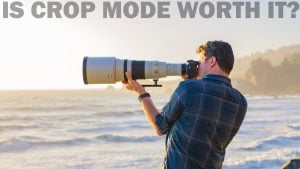

Some full-frame cameras come with crop mode that simulates an APS-C sensor. If you’ve just switched from a crop body to a full-frame camera, you may wonder, “Why on earth would I want to use that?” Well, Brent Hall dives into crop mode on full-frame cameras, giving you some pros, cons, and potential uses for it, even if you swear by a full-frame sensor.
Pros and cons of crop mode
Crop mode essentially crops the image captured by the full-frame sensor, resulting in a zoomed-in image with a smaller field of view. So, for taking sports photos or photographing birds and wildlife from far away, using crop mode could be a great tool!
Brent notes that the crop mode can benefit autofocus, especially with smaller subjects like birds. By cropping in, the camera has a larger area to focus on, leading to more accurate results.
The biggest drawback of crop mode is probably the most obvious one: the loss of megapixels. Basically, it crops the full-frame resolution you’d get otherwise, leaving you with a smaller overall image resolution. If you plan on printing large formats, this could be an issue.
Brent crops his images to 2160 pixels on the long edge, ensuring a clean display on 4K monitors. He also uses software sharpening to enhance details after cropping.
When to use crop mode
Brent suggests that you turn to crop mode for small, close-up subjects. These include insects or birds perched in trees. However, he advises against using it for most bird-in-flight photography. It’s better to use a longer focal length or teleconverter to avoid sacrificing image quality in cases like this.
Crop mode vs. cropping in post
Some photographers argue that cropping in post-processing is preferable to using crop mode in-camera. After all, this allows for more flexibility in composition after you’re done shooting and you transfer your images to your computer. However, Brent finds crop mode useful when he knows he’ll be cropping heavily anyway.
Ultimately, the best approach, as always, depends on your specific needs and preferences. As Brent says, “Opinions just don’t mean anything…go out and try it and then decide for yourself.”
[Wildlife photography with an 800mm F/4? via FStoppers]







